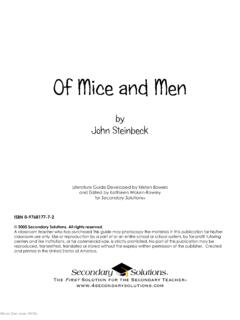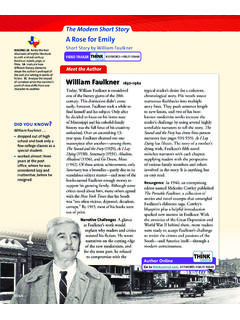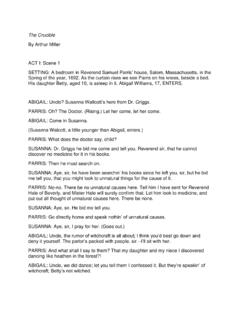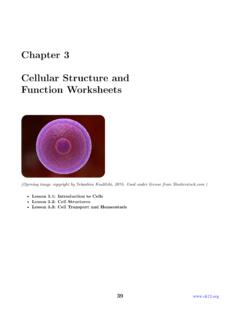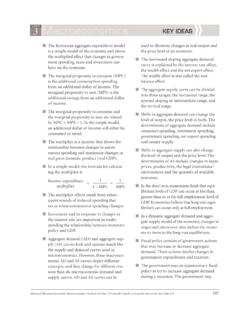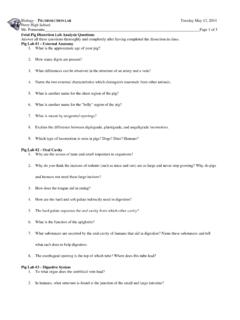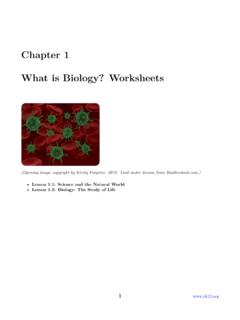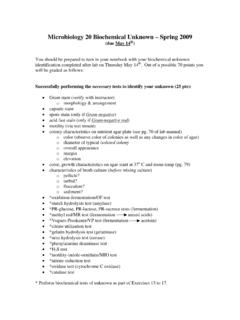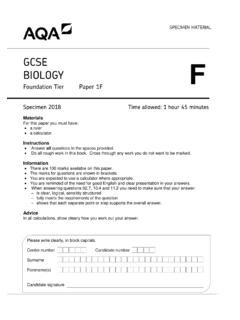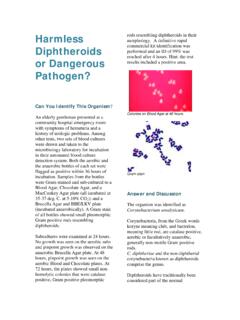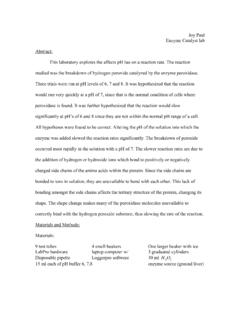Transcription of CATALASE LAB - Chandler Unified School District
1 AP BIOLOGY NAME_____. BIOCHEMISTRY. ACTIVITY #9 DATE_____HOUR_____. CATALASE LAB. INTRODUCTION. Hydrogen peroxide (H2O2 ) is a poisonous byproduct of metabolism that can damage cells if it is not removed. CATALASE is an enzyme that speeds up the breakdown of hydrogen peroxide into water (H2 O) and oxygen gas (O2 ). CATALASE 2 H2O2 2 H2O + O2. Remember: A catalyst is a substance that lowers the activation energy required for a chemical reaction, and therefore increases the rate of the reaction without being used up in the process. CATALASE is an enzyme, a biological (organic) catalyst.
2 Hydrogen peroxide is the substrate for CATALASE . **You w ill be working with hot water, acids and bases in this laboratory**. **Use Extreme Caution!!!**. The general procedure for the lab is outlined below, and specific details for each variable follow. GENERAL D IRECTIONS : The assay system used in this lab consists of a filter paper disc coated with the enzyme and then dropped into a vial of substrate (hydrogen peroxide). As the CATALASE breaks down the hydrogen peroxide into water and oxygen gas, the bubbles of oxygen collect underneath the filter and make it rise to the surface of the hydrogen peroxide.
3 The time it takes for the filter paper disc to rise is an indication of the rate of enzyme activity. R ATE: Rate of enzyme activity is equal to the distance (depth of hydrogen peroxide in mm) divided by the time (in sec) for the disc to rise to the surface. We will assume that each filter is coated with the same amount of CATALASE (except in the investigation of the effect of enzyme concentration on enzyme activity). The enzyme has been prepared for you as follows: 50g of peeled potato was mixed with 50 ml cold distilled water and crushed ice and homogenized in a blender for 30.
4 Seconds. This extract was filtered through cheesecloth and cold distilled water was added to a total volume of 100 ml. Extract concentration is arbitrarily set at 100. units/ml. The enzyme should be kept on ice at all times!! Biochemistry Activity #9 page 1. MATERIALS: CATALASE Ice Hydrogen peroxide 3% and Water baths (0 oC, 37 oC, 100oC). Forceps Vials Filter paper discs Marking pencils Water Stopwatch or timer PROCEDURE : Each group will investigate and report on two of the following questions. Suggested procedures for each question are given below. Every student is responsible for recording the results of all four experiments on this activity.
5 1. What is the effect of enzyme concentration on enzyme activity? 2. What is the effect of substrate concentration on enzyme activity? 3. What is the effect of pH on enzyme activity? 4. What is the effect of temperature on enzyme activity? 1. What is the effect of enzyme concentration on enzyme activity? a. Set up five vials containing 40 mL of 3% hydrogen peroxide each. Measure and record the depth of the hydrogen peroxide in the vials. b. Dilute the enzyme as follows. Make each dilution in a separate cup. 100 units/mL = 20 ml 100 units/ml 80 units/mL = 12 ml 100 units/ml + 3 ml cold dH2 O.
6 50 units/mL = 10 ml 100 units/ml + 10 ml cold dH2 O. 20 units/mL = 3 ml 100 units/ml + 12 ml cold dH2 O. 0 units/mL = 20 ml cold dH2 O. c. Using forceps, dip a filter into the enzyme solution at 100 units/ml, then remove it and drain it on a paper towel. d. Drop the disc into the vial of hydrogen peroxide labeled 100 units/ml and time how long it takes the filter to rise to the surface. e. Repeat this procedure for each of the other enzyme dilutions, and be sure to use a FRESH vial of substrate for each filter. f. Record your results in the appropriate data chart.
7 Biochemistry Activity #9 page 2. 2. What is the effect of substrate concentration on enzyme activity? a. Obtain 1 vial of CATALASE at 100 units/mL. b. Dilute the substrate (hydrogen peroxide) as described below. Each dilution should be made in a separate labeled vial. Measure and record the depth of the hydrogen peroxide. H2O2 : 40 mL 3% H2 O2. H2O2 : 20 mL 3% H2 O2 + 20 ml distilled water H2 O2: 10 mL 3% H2 O2 + 30 ml distilled water H2 O2: 5 mL 3% H2O2 + 35 ml distilled water H2O2 : 40 mL distilled water c. Dip a filter into the CATALASE , drain on a paper towel and then drop the filter into the 3% H2O2.
8 D. Time how long it takes the filter to rise to the top. e. Repeat this procedure for each of the substrate dilutions. Record your results in the appropriate data chart. 3. What is the effect of pH on enzyme activity? a. Obtain 1 vial of CATALASE at 100 units/mL. b. Set up 5 vials of 40 mL 1% H2 O2 . Measure and record the depth of the hydrogen peroxide. c. Label 5 small vials as follows: pH3, pH5, pH7, pH9, pH11 and dilute CATALASE into the appropriate vial as directed below: pH 3: 5 mL CATALASE + 5 mL pH 3 Buffer pH 5: 5 mL CATALASE + 5 mL pH 5 Buffer pH 7: 5 mL CATALASE + 5 mL pH 7 Buffer pH 9: 5 mL CATALASE + 5 mL pH 9 Buffer pH 11: 5 mL CATALASE + 5 mL pH 11 Buffer d.
9 Dip a filter into the CATALASE at pH 3, drain on a paper towel and drop it into the 1% H2 O2 . e. Time how long it takes the filter to rise to the top. f. Remove the filter and repeat this procedure for each pH. g. Record your results in the appropriate data chart. Biochemistry Activity #9 page 3. 4. What is the effect of temperature on enzyme activity? a. Obtain 1 vial of CATALASE at 100 units/mL. b. Set up an ice bath (0oC), a room temp water bath, a 37oC bath and a boiling water bath c. Place 5 ml of CATALASE at 100 units/ml in each of 4 test tubes. Place 1 test tube in each of the water baths.
10 D. Place 40 mL 1% H2O2 in each of 4 vials. Measure and record the depth of the H2O2 . Place 1 vial in the 0 o C bath and leave 3 at room temperature. This is necessary because heat will destroy the hydrogen peroxide. e. Allow the CATALASE and substrate to incubate at each temperature for about 5 minutes, then test the reaction time at each temperature by dipping a filter into enzyme at that temperature, draining it, and then dropping it into substrate at the same temp. f. Use the second room temperature vial of hydrogen peroxide for the boiled CATALASE . Do not boil hydrogen peroxide!
